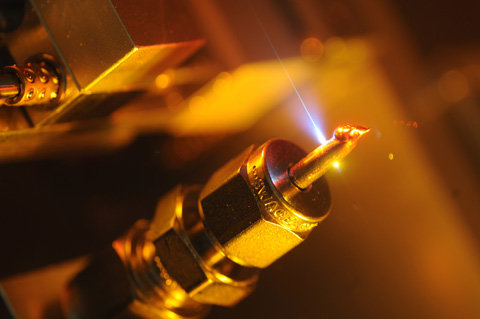Electrons in motion
In order to understand the behavior of atoms and molecules, it does not suffice to know their structure, but physicists furthermore want to observe their motions, and the motions of the electrons that are contained in them.
Because electrons move so rapidly, this was not possible until now. However, a European team of researchers has now developed a method that allows to observe the motions of electrons. Their report was recently published in Physical Review Letters, 30 July 2010.
The world of atoms and molecules is very different from our everyday experience. We like to think of electrons as little particles. “And that is to some extent a valid picture” explains Marc Vrakking, director at the Max Born Institute in Berlin, “but quantum mechanics also forces us sometimes to consider the wave-nature of electrons”. Using this abstract representation of an electron, physicists can explain intriguing phenomena that in the end connect to our simple picture of the electron as a particle.
Because it is not possible to observe the motions of electrons directly, the European research team characterized this motion by a number of separate measurements that completely characterized the wave-nature of the electron, or, as Vrakking likes to call it “the electronic wavepacket”. With this, the particle-like motion of the electron is completely defined.
In the experiment, the researchers have exploited the fact that waves can be made to interfere. In many respects their experiment resembled the famous double-slit experiment that Thomas Young performed at the start of the 19th century, where light fell onto a pair of slits and an interference pattern was observed on a screen placed downstream. The way to understand this observation is to view the incident light as a wave, and to view the interference pattern as a consequence of the fact that light passing through one slit may be in- or out-of-phase with light passing through the other. This observation cannot be explained when viewing the incident light as a collection of particles (“photons”).
In order to characterize an electronic wavepacket, the researchers have also used interference, and have exploited the interference between an (“unknown”) electronic wavepacket that they wanted to characterize and a reference (“known”) wavepacket, that they produced with an attosecond laser pulse, by ionizing the atom. The properties of this reference wavepacket are fully known because they follow from the properties of the fully-known attosecond pulse. By overlapping and interfering the two wavepackets, and observing the interference pattern that resulted, they could extract all the properties of the unknown wavepacket.
Matthias Kling scientist at the Laboratory for Attosecond Physics at the Max-Planck Institute of Quantum Optics (Munich) explains the method: “Initially the reference wavepacket produced by the attosecond laser has a much higher energy than the unknown wavepacket. In order to create the interference pattern, we therefore had to lift the unknown wavepacket to the same energy. We have done this using an infrared laser pulse. By varying the time-delay between the attosecond pulse and the infrared pulse we could acquire a whole series of interference patterns, which allowed to extract all that there is to be known about the unknown wavepacket.”
A full characterization of the electronic wavepacket follows from a knowledge of the energies, the populations and the relative phases of all the states that contribute to the wavepacket. Once known, the time-dependent motion of the electronic wave can be pictured, and the picture of a particle-like motion re-emerges, bringing us back to our everyday world.

Picture description: Generation of attosecond light flashes to observe the movements of electrons. Courtesy of Thorsten Naeser
Contact:
Prof. Dr. Matthias Kling
Max Planck Institute of Quantum Optics , Garching
Max Planck Research Group „Attosecond Imaging“
Phone: +49 (0)89 32905 -234 / Fax: -649
E-mail: matthias.kling mpq.mpg.de
http://www.attosecondimaging.de
Dr. Olivia Meyer-Streng
Press & Public Relations
Max Planck Institute of Quantum Optics
Phone: +49 (0)89 32905 -213
E-mail: olivia.meyer-streng@mpq.mpg.de
